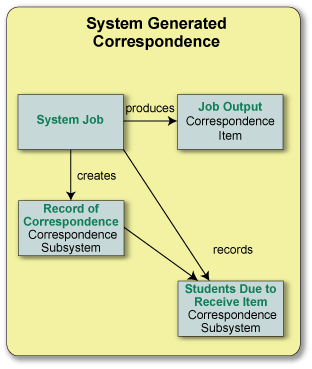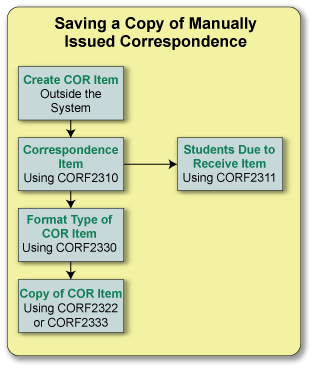
| Top of COR | Index | Table of Contents | Feedback |  |
CORINTR3 - Understanding Correspondence
This section of the user manual provides an overview of the Correspondence Subsystem . Topics covered include:
Detailed explanations and instructions for the use of individual database forms can be accessed from the Subsystem's Table of Contents or via the numerous links provided here.
Information regarding Subsystem reference data and setup is provided separately for the Subsystem Specialist.
What Does the Correspondence Subsystem Do?
This Subsystem maintains a record of the correspondence sent to students. Records of System generated correspondence are created automatically by the System. Records of manually produced correspondence are recorded by users.
This Subsystem does not generate correspondence. Generation of correspondence is done by other Subsystems operating in conjunction with the Job Control and Scheduling Subsystem.
There are two mechanisms for letter production. For example:
This Subsystem is used to:
and to:
Terms Used in the Correspondence Subsystem
To understand the Correspondence Subsystem it is necessary to understand the following key terms. Explanation of all Correspondence terminology is provided in the Subsystem Glossary.
| An institution defined type of correspondence which may be System or manually generated. Enrolment Form, Fee Invoice and Results Advice are examples of System generated Correspondence Types. Handbook, Campus Map, Accommodation Guide and Special Letter are examples of manually generated Correspondence Types. |
|
| Correspondence Item |
A Correspondence Item is a 'piece' of correspondence of a particular Correspondence Type created on a particular day and time. Therefore an Enrolment Form created by a job run at 10:45 on 1/8/03 is a Correspondence Item. An Enrolment Form created by a job run at 18:30 on 15/9/03 is another Correspondence Item. A single Correspondence Item may be issued to more than one student. For instance, the Enrolment Form created on 1/8/03 may be sent to thousands of students. Each student receives the same Correspondence Item - an Enrolment Form - incorporating the student's individual person, Course and Unit information. |
| Correspondence Category |
A Correspondence Category is used to define sets of System generated and non System generated Correspondence Items which are due to be sent to a student. A Correspondence Category is assigned to a student during the admissions process. |
| Letter Phrase |
A Letter Phrase is used to define specific text to be included in the creation of System Letters. One or more Letter Phrase/s are assigned to a Letter Parameter of type 'PHRASE', prior to production of a System Letter. |
| Letter Parameter |
A Letter Parameter is used to define specific text, System data or rules generated text, which is to be included in a System Letter. A Letter Parameter is mapped to a System Letter Parameter type. System Letter Parameter types determine the functionality of Letter Parameters. Multiple Letter Parameters can be mapped to a System Letter Parameter Type. Letter Parameters must be mapped to a System Letter definition, and included on a template. |
| System Letters |
System Letters are definitions of particular Correspondence Types. Multiple System Letters can be mapped to Correspondence Types. A System Letter's definition includes all Letter Parameters that the institution might wish to include in a letter. |
| Letter Templates |
Letter Templates are Microsoft Word defined documents that include Letter Parameter Codes. By the use of control.doc (a file containing macro's), data from Callista is merged into the template using the placement and formatting assigned to the Letter Parameter Codes. |
How the Correspondence Subsystem is Used:
How Correspondence Items are Created
Correspondence Items are created either by the System (from Subsystems other than Correspondence) or manually.
 |
When a System job which produces correspondence (e.g. production of enrolment forms) is run, the System creates a record in this Subsystem of details of the Correspondence Item and a record of each student due to receive it. When a Correspondence Item has been mailed, the Date Sent field for this Correspondence Item can be updated for all students receiving it, by scheduling the Update Outgoing Correspondence Date Sent job (CORJ2440) in the Job Scheduling Subsystem. |
| When a Correspondence Item is manually issued to students and a record of this correspondence is required, the record is created in this Subsystem by: |
|
 |
Where a copy of the manually issued Correspondence Item is to be saved, the procedure is to:
Steps 2. and 3. can be transposed. |
How Correspondence Items are Viewed
Details of Correspondence Items recorded in the System are viewed in the Register Correspondence Item form (CORF2310). Queries can be performed in this form, returning either individual Correspondence Items or multiple records depending on the query criteria used.
Where a copy of a manually recorded Correspondence Item has been saved, it can be viewed by selecting the Detail button in CORF2310 and either the Edit (for OLE and text items) or View (for postscript items when this functionality is developed in the future) button in the Correspondence Detail form (CORF2330).
To See a List of the Correspondence Sent to an Individual Student
The Maintain Outgoing Correspondence form (CORF2320) is used to see a list of the correspondence which has been sent to an individual student. Queries can be performed in this form using a student's ID number.
Where a copy of a manually recorded Correspondence Item has been saved, it can be viewed by selecting the Detail button in CORF2320 and either the Edit or View button in the Correspondence Detail form (CORF2330).
To see a List of Students Sent a Particular Correspondence Item
The Outgoing Correspondence Detail form (CORF2311) is used to view a list of students sent a particular Correspondence Item. Queries cannot be performed on Correspondence Item but students receiving the displayed Correspondence Item can be queried using the Find Person form (ADMF1211).
To display the desired list:
To update the Date Sent field for an item with many recipients, use job CORJ2440 via the Job Scheduling Subsystem.
How System Letters are Produced
System Letters, are produced from within particular Subsystems. In general, individual System Letters are designed by the correspondence or Subsystem Specialist for specific Correspondence Types, and assigned to be used for particular categories within a Subsystem. For example, an Admission Application Outcome Letter can be created specifically for the Admissions Subsystem, and assigned to an Admission Process Category for international full-fee paying students. All students who are admitted via this Admission Process Category, will be sent the same letter, with specific text that applies to the individual.
System Letters, generally, can have phrases added to them, to personalise the letters. Phrases are added to System Letters by allocating a Phrase Code to a Letter Parameter Code (the Letter Parameter must be assigned to System Letter Parameter Type of 'PHRASE').
Refer to the following for information regarding System Letter production for specific Subsystems:
For full details on how to send an Electronic message see CORJ5000.
Last Modified on 4 March, 2004